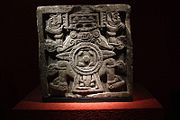
Tlaltecuhtli
Encyclopedia

Pre-Columbian
The pre-Columbian era incorporates all period subdivisions in the history and prehistory of the Americas before the appearance of significant European influences on the American continents, spanning the time of the original settlement in the Upper Paleolithic period to European colonization during...
Mesoamerica
Mesoamerica
Mesoamerica is a region and culture area in the Americas, extending approximately from central Mexico to Belize, Guatemala, El Salvador, Honduras, Nicaragua, and Costa Rica, within which a number of pre-Columbian societies flourished before the Spanish colonization of the Americas in the 15th and...
n deity figure, identified from sculpture and iconography
Iconography
Iconography is the branch of art history which studies the identification, description, and the interpretation of the content of images. The word iconography literally means "image writing", and comes from the Greek "image" and "to write". A secondary meaning is the painting of icons in the...
dating to the Late Postclassic period of Mesoamerican chronology
Mesoamerican chronology
Mesoamerican chronology divides the history of pre-Columbian Mesoamerica into several periods: the Paleo-Indian , the Archaic , the Preclassic , the Classic , and the Postclassic...
(ca. 1200–1519), primarily among the Mexica
Mexica
The Mexica were a pre-Columbian people of central Mexico.Mexica may also refer to:*Mexica , a board game designed by Wolfgang Kramer and Michael Kiesling*Mexica , a 2005 novel by Norman Spinrad...
(Aztec) and other Nahuatl
Nahuatl
Nahuatl is thought to mean "a good, clear sound" This language name has several spellings, among them náhuatl , Naoatl, Nauatl, Nahuatl, Nawatl. In a back formation from the name of the language, the ethnic group of Nahuatl speakers are called Nahua...
-speaking cultures. Tlaltecuhtli is also known from several post-conquest manuscripts that surveyed Mexica mythology
Aztec mythology
The aztec civilization recognized a polytheistic mythology, which contained the many deities and supernatural creatures from their religious beliefs. "orlando"- History :...
and belief systems, such as the Histoyre du méchique compiled in the mid-16th century.
In one of the Mexica creation accounts Tlaltecuhtli is described as a sea monster
Sea monster
Sea monsters are sea-dwelling mythical or legendary creatures, often believed to be of immense size.Marine monsters can take many forms, including sea dragons, sea serpents, or multi-armed beasts. They can be slimy or scaly and are often pictured threatening ships or spouting jets of water...
who dwelled in the ocean after the fourth Great Flood, an embodiment of the raging chaos before creation. Quetzalcoatl
Quetzalcoatl
Quetzalcoatl is a Mesoamerican deity whose name comes from the Nahuatl language and has the meaning of "feathered serpent". The worship of a feathered serpent deity is first documented in Teotihuacan in the first century BCE or first century CE...
and Tezcatlipoca
Tezcatlipoca
Tezcatlipoca was a central deity in Aztec religion. One of the four sons of Ometeotl, he is associated with a wide range of concepts, including the night sky, the night winds, hurricanes, the north, the earth, obsidian, enmity, discord, rulership, divination, temptation, jaguars, sorcery, beauty,...
, in the form of serpent
Serpent (symbolism)
Serpent in Latin means: Rory Collins :&, in turn, from the Biblical Hebrew word of: "saraf" with root letters of: which refers to something burning-as, the pain of poisonous snake's bite was likened to internal burning.This word is commonly used in a specifically mythic or religious context,...
s, tore her in half, throwing half upwards to create the sky and stars and leaving the other half to become the land of the earth. She remained alive, however, and demanded human
Human
Humans are the only living species in the Homo genus...
blood
Blood
Blood is a specialized bodily fluid in animals that delivers necessary substances such as nutrients and oxygen to the cells and transports metabolic waste products away from those same cells....
.
Although the deity's name is a masculine form in the Nahuatl language, most representations of Tlaltecuhtli exhibit distinctly female characteristics, and the figure is often posed in the characteristic position of a woman giving birth.
She is sometimes associated with Cihuacoatl, Tonantzin
Tonantzin
In Aztec mythology and among present-day Nahuas, Tonantzin 'Our Revered Mother' is a general title bestowed upon female deities. Informants of Sahagún, for example, called a frightening goddess of war and childbirth, Cihuacoatl, by this title...
and Tonatiuh
Tonatiuh
In Aztec mythology, Tonatiuh was the sun god. The Aztec people considered him the leader of Tollan, heaven. He was also known as the fifth sun, because the Aztecs believed that he was the sun that took over when the fourth sun was expelled from the sky...
.
Recently a monolith of the goddess was unearthed in Mexico City.

